-
Posts
14,343 -
Joined
-
Last visited
-
Days Won
25
Content Type
Profiles
Forums
Blogs
Gallery
Events
Store
Posts posted by Ed_Haynes
-
-
Thanks for posting this almost mythical beauty!
 0
0 -
Nice to see the box! See also http://gmic.co.uk/index.php?showtopic=1245&st=4 and the following post.
0 -
BUT, must we have the glib, prejudiced and very frequently factually wrong pseudo political commentary?
I had hoped to avoid such attacks by posting here, rather than in the "British" section. It seems I was wrong and I now regret having posted.
Let me just say that I have worked in the records, in the archives in the UK and in India. This forum, does not permit footmnotes and references. I shall save these for a more extensive academic publication. But why bother here . . . .
Thanks, though, for the "Royal Ark" reference. When I last looked at his site he did not cover Bharatpur. (The site is now closed, however.)
0 -
Shall do so, tomorrow, Hugh.
And may even throw in some groups.
 0
0 -
Should you wish, you may wish to glance at http://gmic.co.uk/index.php?showtopic=29710
0 -
PS- Should anyone care (?), I can add a few examples of the royal "hanger-on" badges for the trips to India or of groups containing these medals. But most would, probably, rather see groups to Europeans, and these can better be posted in The Other Sub-Forum?
You only need to ask.
0 -
On 20 January 1936, King-Emperor George V died and the presumed accession of his son as King-Emperor Edward VIII launched the empire into an as-yet-unequalled constititional crisis.
After much agony, the late ruler's second son came to the throne as King-Emperor Gerge VI in December 1936.
While the wheels in India had been put into motion for a (proposed) durbar for Edward VIII (and designs had actually been launched for a Durbar Medal and other awards), these soon came to a screeching halt.
As events unrolled, it became increasingly obvious that (1) Edward VIII would not become king-emperor, (2) that his brother would come to the throne as George VI, (3) that while the new King-Emperor George VI had never visited India, he had no particular personal inclination toward either international travel nor visiting India (his brother, after all, had had no fun at all while there), (4) that the political situation in India had altered substantially from the troubled days when Edward VIII (as Prince of Wales) had visited India and that the visit of a new ruler would not (most emphatically NOT) be a happy political experience in the post-Salt-March late 1930s, and (5) that the international political situation -- especially in Europe in 1937/38 -- had reached a point when the foreign travel of the king was not a recommended act.
Schemes were developed for a special clasp for George VI's (familiar?) Coronation Medal for a Delhi durbar (whenever that took place, and which he did NOT plan to attend). Indeed, discussion was also given to an otherwise-unreported and mysterious distinction between the "military" and "civil" versions of that medal's ribbon.
All these plans, of course, came to mean nothing as events in Europe, elsewhere, and, especially, in India brought the institution of "king-emperor" to an end on 15 August 1947.
0 -
In 1921-22, the Prince of Wales (later Edward VIII) again visited India and, again, a medal was issued to a small number of individuals (mainly Indian) who assisted in his visit. It is estimated that ony 84 of these medals (again, all in silver) were awarded. (And, again, I appreciate permission to uses a rarely ribboned example -- which isn't mine.
 )
) Unlike his father's (or grandfatherr's) experience, this Prince of Wales has less tha "fun" and experieces a substantially increasedl evel of Indian opposoition to foreign rule. This negative experience would have results with his --and his brother's -- view of India and of Indian visits.
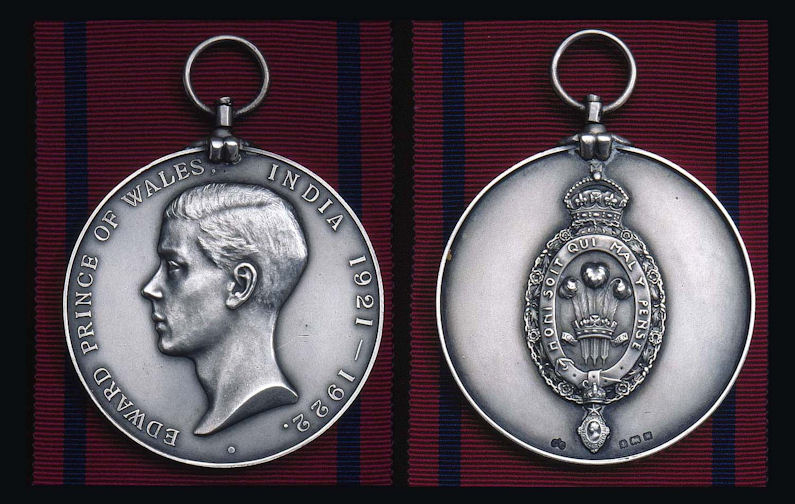 0
0 -
The silver medals were much more widely awarded than had been the case with his father's medals. In part this was the result of a changing "public relations" imperial need and in part it had been the result of massive complaints after the 1903 durbar. While just around 2,567 Edward VII silver medals had been awarded, some 30,000 (and this estimate is very low!) George V silver medals were awarded. And this number does not include the (rather small) body of 134 recipients of both his coronation medal and the specially struck "DELHI" clasp to the coronatiion medal -- discussed elsewhere -- to avoid multiple awards. (It was a specific concern to avoid duplicate award for the coronation and durbar as had "afflicted" Edward VII's accession, and this concern would carry over to the next generation).
A sdample silver medal, in this case awarded (and named) to "Rao Raja Jugal Saran Singh. Bharatpur." While he was clearly a part of the 'royal' hangers-on from Bharatpur State (in Rajputana) his satisfactory indentification is elusive at present.
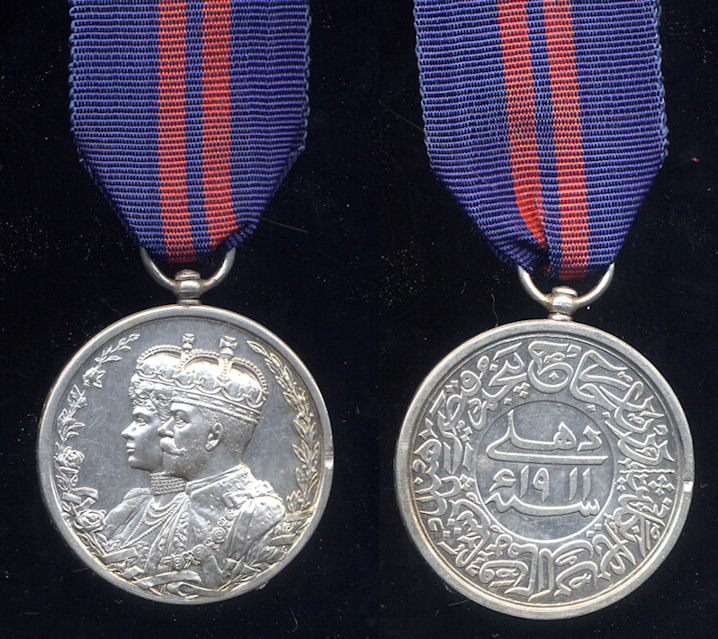 0
0 -
With his father's death on 6 May 1910, the new King-Emperor decided (in concert with his India Administration) to break with tradition and actually to visit (once again) India for his coronation as Emperor of India (this required the creation of a new Crown of India etc., at full Indian expense -- this provided both a nice ongoing decoration for the tower of London and a focus for the growing Indian opposition to British colonial rule). George V would be the first (and last) king-emperor actually to travel to India.
Once again, in Delhi, a durbar was held to mark his accession/coronation as Emperor of India.
A medal, in gold, was issued to those ruling princes in attendance and to senior British officials. As before, non-rulers could not wear the medal in gold (est. total 200 issued) outside India. This specimen, awarded to the Vicerene Winifred, Lady Hardinge of Penshurst, C.I., K.i.H., is therefore a bit of an exception. While unnamed (and extracted from a group), it represents an interesting example.
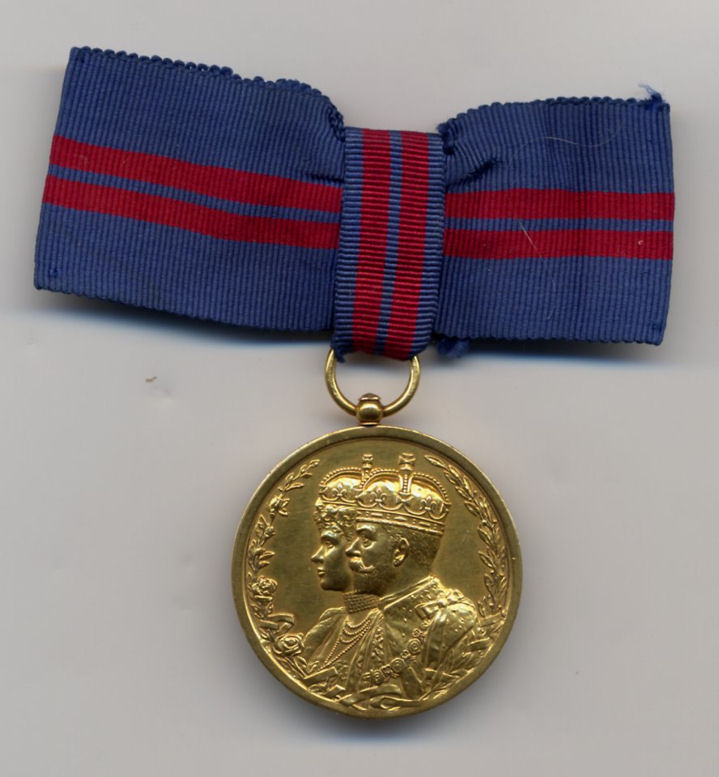 0
0 -
In 1905-6, the new Prince of Wales followed in his father's footsteps (well, not quite -- he brought his wife along) and visited India. A special and quite ambiguous commeorative medal was awarded to those who assisted him as a special royal gift (just 70 specimens). This gift would confuse generations of Indian officials. While I have one in a group, the specimen is shown (by pertmission) is with ribbon (which is rarer than the medal.
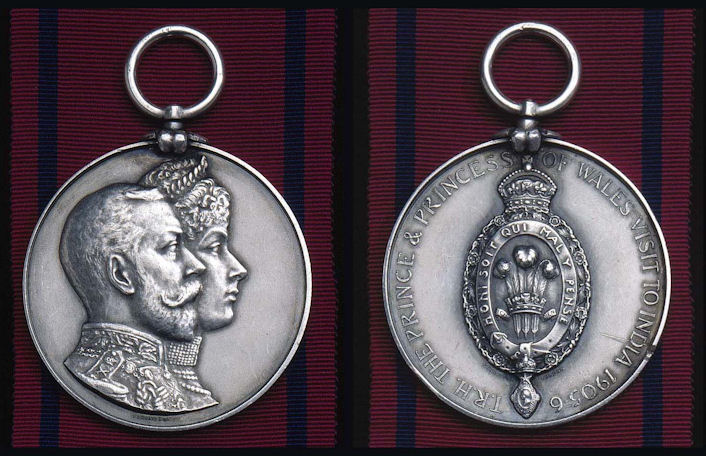 0
0 -
This in silver (est. only 2567 awarded) was given to those (militray and civilian offficials) actually present at the durbar (this will be become important). This medal (alas) in unnamed and unattributed (though I may add some attributed groups later if there if there is any interest).
(The published rolls of military recpients [only!?!], by the way, are quite laughable, and the fact that they were prepared from PRINTED rolls is quite a sad and embarassing shame.)
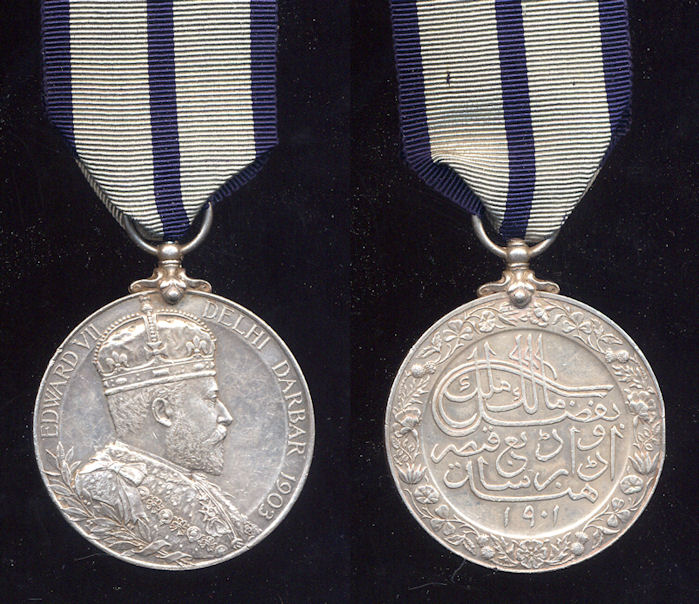 0
0 -
With the death of the Queen-Empress, a formal durbar was convened in Delhi in 1903. While the new king-emperor was absent, gold medals (est. 140) were awarded to ruling "princes" at others of prominence who attended the gathering (under the intimate supervision of the Viceroy, Lord Curzon). While many were privately and semi-officially named, most were not. This gold one (alas
 ) does not live with me, but I have been allowed to post the image.
) does not live with me, but I have been allowed to post the image.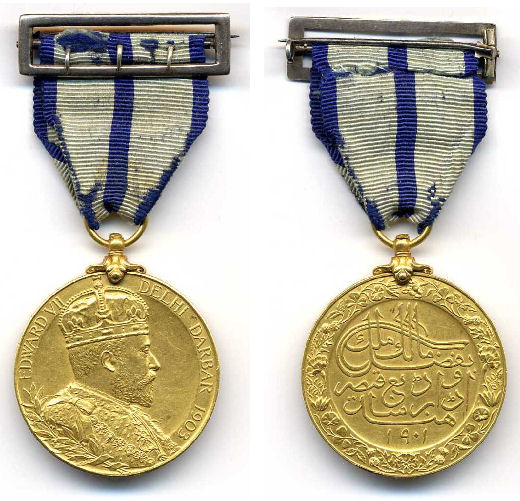 0
0 -
To "lesser personages", the medal was awarded in silver. In this case the medai is named to "Dewan Trilok Nath", believed to be Lala Triloki Nath Singh, Talukhdar of Shahganj, NWP & Oudh. He is known to have been present in Delhi for the durbar.
As these medals were not allowed to be worn by European personnel in uniform or outside Europe, their status remained ambiguous in some circles, though in India (among both Indians and Europeans) these medals remained much respected.
 0
0 -
When the Prince retuned home, his "discovery of India" conjoined with a growing desire to extract his mother from her post-Albert mouring, with a new and increasingly aggressive British racial confidence and rescurrected neo-imperialism, and with a felt need to define just WHAT the British role had been in India since the dismantlement of the East India Company in 1859.
With careful work between the Prime Minister and Viceroy, a Durbar was convened in Delhi (then, a backward proivincial town but with much historical symbolic value) to proclaim Queen Victoria as the "Empress of India" (actually, in Indian and nearby languagues, as "Emperor of India", a subtle gender-linked vocabulary distinction).
A medal was issued to those in attendance. In gold to the "Ruling Princes" and senior British oficials in attendance (the rolls have been located in New Delhi but, as yet, are unseen). While many were named (again, as the recipient's cost from the mint), this one is unnamed.

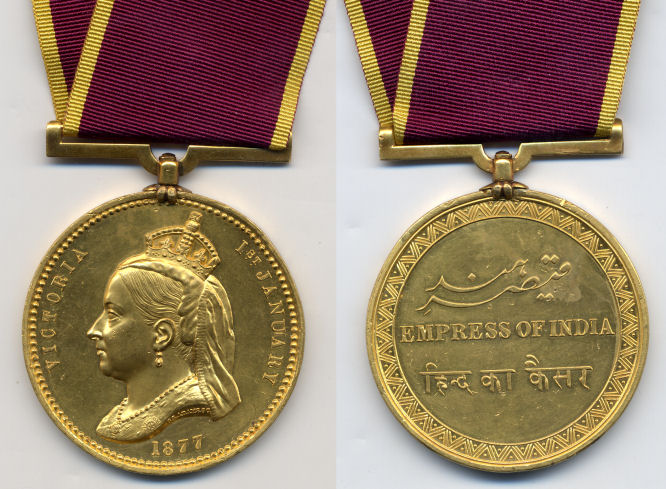 0
0 -
Arguably, the whole idea for these awards begins with the 1875 visit to India by the Prince of Wales (later Edward VII), which may have been as much scheme to get his often embarassing (to Mom) person out of the UK as anything else. Without consulting London (or, for that matter, the Government of India in Calcutta), the Prince awarded silver and gold medals to those proiminent individuals who he met, who attened his various durbars (see below), and who he otherwise wished to honor.
"Durbar" = An important word. A ceremonial gathering of subordinate (or so the conever believed them to be) individuals who, by their very presence and implicit permission to engage in the ceremonies involved, had proffered their allegiance to the legitimacy of the individuals who had convened the gathering.
While the details are rather vague, during his 1875 visit the Prince of Wales awarded massive neck-worn medals (on the ribbon of the new order of the Star of India) to those he met during his trip (killing animals [etc.] much of the time). These were numbered and could, if the recipient desired, be returned to the Indian Mint for naming (which made the Mint much less than happy).
The medal was awarded in perhaps 48 examples in gold and 165 in silver (bronze and white metal specimans exist, biut seem to have been mere souveniers from the mint). This (silver) specimen (No. 11) was named up to "MAHARANA GUMBHIR SINHJI RAJA OF RAJPIPLA". He was born in 1847 and ruled from 1860 to 10 January 1897. I still seek of photo of him weraring this medal. (Rajpipla was a major regional state just north on the coast from Mumbai -- then, Bombay.)
As for all the other 'royal' visits to India, special, commemorative medallions were issued for those (Europeans) who accompanied them, but (for the moment) I exclude them from this consideration.
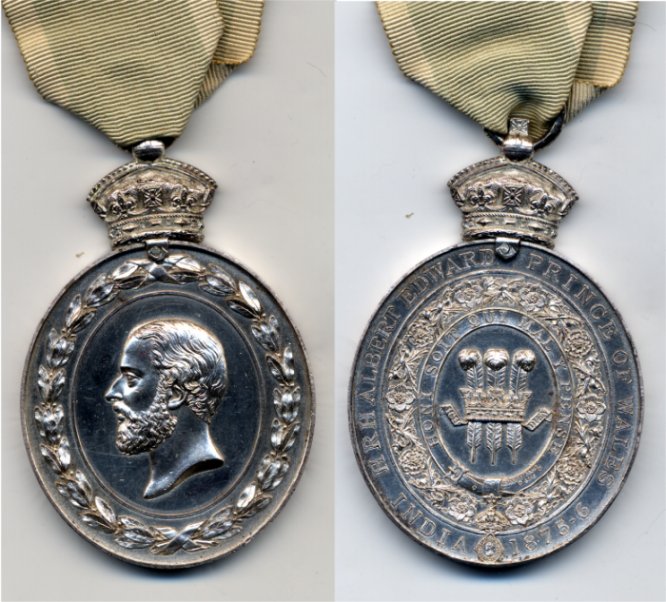 0
0 -
-
Very tasty eye-candy, Rick!

 0
0 -
Interesting. Maybe the Ukranian Order of Prince Yaroslav the Wise?
See: http://www.medals.org.uk/ukraine/ukraine-r...republic001.htm
0 -
Insanity does love company. Just look at us. Shall, at some stage, post the bulk of my collection, somewhere.
0 -
Lovely things.
And nicely scanned too.
 0
0 -
I can read some Arabic, but neither well nor quickly. In any case, without a better scan I am not sure any of us will be able to say much about this badge.
0 -
Any chance of a larger scan?
0 -
Disturbing, but at least no murder was involved. May we assume this was a "robbery to order" and that these medals are now in some rich person's hidden collection?
0




Medal for International Brigades in Spain 1936-39
in Central & Eastern European States
Posted
Let me get it and scan the document in detail (and legibly) here . . . .